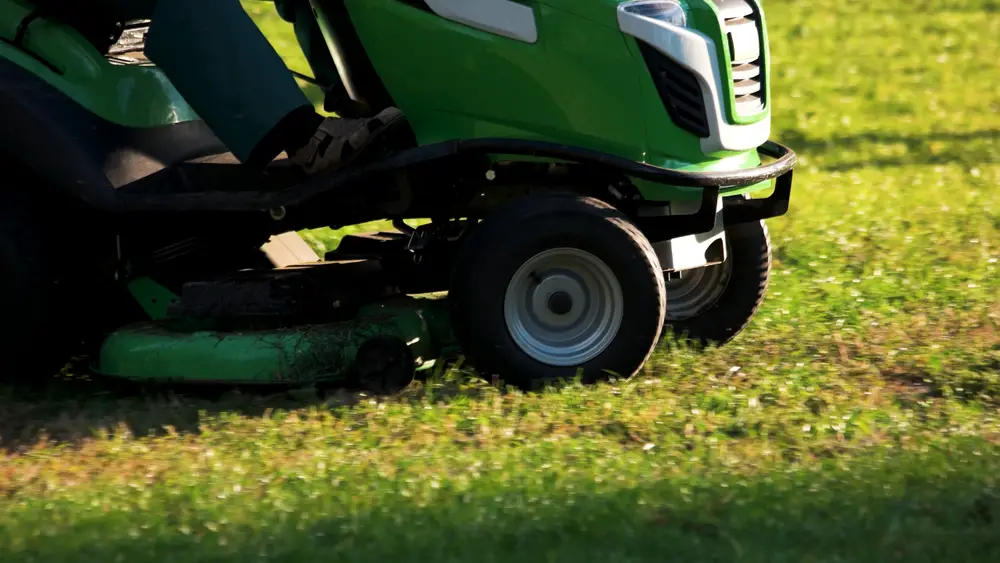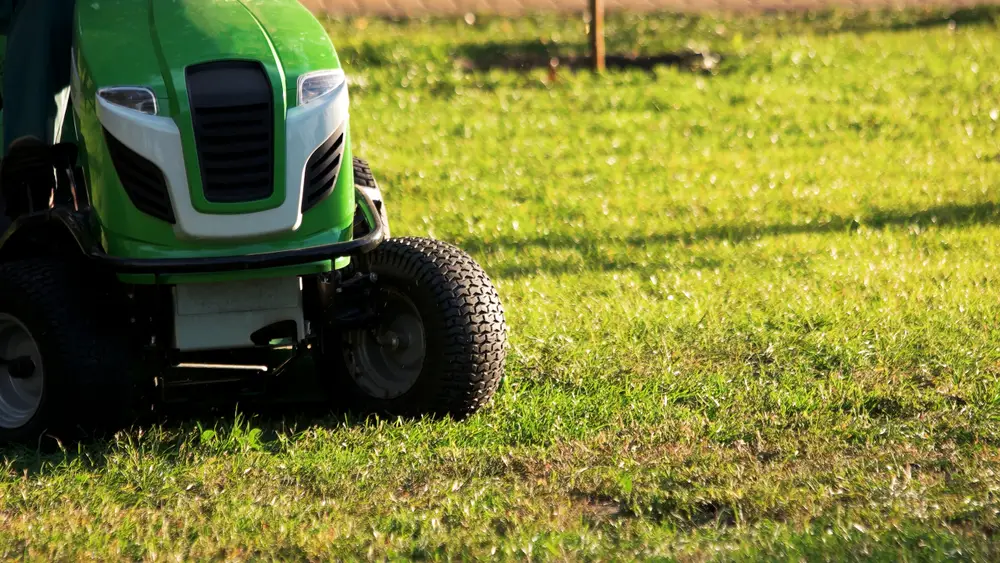John Deere lawn mowers are used for cutting and mowing grasses on uneven or rough grounds. Because of this reason, the tires can wear down and become flat. So, if that happened to you and you want to know how to fix a flat tire on a John Deere riding lawn mower, you’ve come to the right place.
In this content you’ll learn:
7 Steps For How To Fix A Flat Tire On A John Deere Riding Lawn Mower

There are two easy ways to fix a flat tire. You can seal it or replace the tire with a new one. We’ll explore each in turn. Beforehand, let’s get into what makes a tire go flat.
Step 1: Figure Out The Reason For The Tire Going Flat
There are lots of reasons for tires to go flat, but the main one is uneven and bumpy ground. If a lawn mower keeps running over this kind of ground, then it will get worn down and become flat.
Heat is another factor that can make tires go flat. The heat from the sun and other sources can increase tire pressure. This can strain them, making them vulnerable to going flat or outright popping.
Sharp objects can also make tires go flat too. For example, sharp rocks or screws.
You may not be able to figure out why the tire has gone flat without removing it first, but it’s worth a try to help you to decide what to do.
Step 2: Get Your Tools
Every job needs the right kind of tools. Here are the ones you’ll need to fix that flat tire on your John Deere riding lawn mower:
- Pneumatic jack or hydraulic jack
- Lever or screwdriver
- Long-nosed pliers
- Tire sealant
- Air compressor
- Valve core remover
- Water and soap
- New tire
- Safety glasses
- Work gloves
Step 3: Practice Good Safety
Before fixing a flat tire, make sure the lawn mower is off and on an even ground. Put on safety glasses and work gloves. Remove all jewelry too. Remember too that if you don’t feel comfortable doing this yourself, you can always contact a professional.
Step 4: Remove The Flat Tire
There are several steps to removing a flat tire. We recommend checking your product manual before starting, as it may have some tips or steps of its own. That said, here’s what to do.
1. Put The Lawn Mower On The Pneumatic Jack
Just like jacking a car up, you’ll need to do the same for a riding lawn mower too. If you have a piece of plywood, slide that underneath the lawn mower. This provides a good base for the jack, just make sure the wood covers the whole area the lawn mower is sitting on.
Next, slide the jack underneath the front or back of the lawn mower. This depends on where the tire is that you need to fix. For example, if the tire is in the back, you’d slide the jack under the back.
Every lawn mower is a little different, but, in general, you can jack a lawn mower up by the front or rear axle. If you’re still unsure, sometimes product manuals will explain where to put a jack.
Once the jack is in place, begin jacking the lawn mower up until it’s high enough for the tire to spin freely. At this point, place the jack stands underneath whatever axle you’re jacking up, then lower the lawn mower until the axle is resting on the stands.
2. Remove The Flat Tire
Removing the flat tire is very simple. First, you’ll need to remove the cap covering the center of the wheel. The easiest way to pry this off would be with a crowbar.
Once the cap is off, you’ll need to remove a clip and washer. Pliers can help here. Once these are removed, you can slide the wheel off. Sometimes wheels come off easily, other times they need some elbow grease.
Step 5: Figure Out What Made The Tire Go Flat (If You Haven’t Already)
Depending on how you’re going to fix the flat tire, you’ll need to know exactly where the leak is that’s making it go flat. Your first option is to eyeball the tire. Your second is to move your fingers across the tire’s surface to see if you can locate it.
Another option is to fill a spray bottle with soap and water. Spray this mixture over the tire. Wherever the leak is, the soapy water will start to bubble up.
Step 6: Fix The Flat Tire
There are three ways to fix a flat tire. Let’s start with the first: sealing.
Option 1: Sealing The Flat Tire
Before going with this option, please know that tire sealant is not a permanent option. Still, some tire sealants can last for a couple of years. Even if they don’t, tire sealant would be a good choice if you’re just trying to finish mowing or in a rush. Some sealants can help prevent flats if you use them before leaks ever happen.
Most lawn mower and tire sealant manuals will have instructions to help you through this process. Here’s usually what that will look like.
1. Remove The Valve Core
Not every sealant will require you to do this. The valve core is the little metal piece you see when you unscrew the cap to fill your tires up with air. Removing this piece will deflate your tire (and require you to have an air compressor to fill it back up).
If you do need to remove the valve core, insert the valve core remover into the valve stem. Rotate the tool until the valve core comes out. To be safe, do this slowly and keep your face away from the area as there could be a blast of air.
2. Remove The Sharp Object
If the flat is due to a sharp object, carefully remove that object.
3. Inject Tire Sealant
Whether or not you have to remove the valve core, the next step is injecting the tire sealant. Most tire sealants will have instructions for this on the product itself. It’s usually as simple as connecting the included hose and injecting the sealant either manually or with the push of a button.
4. Replace The Valve Core
Once you’ve injected the proper amount of sealant, replace the valve core. Wipe away any extra sealant.
5. Inflate The Tire
If you had to remove the valve core, then you’ll need to use the air compressor to reinflate the tire.
6. Spin The Tire
To make sure the sealant is properly spread throughout the tire, spin the tire a few times. Afterward, give it a test drive at a slow speed to make sure the tire stays inflated.
Option 2: Replace The Whole Tire
Maybe the tire is too badly damaged to be fixed. In that case, it’s time to replace it. Since you’ve already removed the flat tire, all you need to do in this case is to put the new tire on, replace all the parts you removed, and you’re good to go!
Step 7: Test Drive The Lawn Mower
Before using your lawn mower to mow again, test drive it on even ground. Make sure the tire is holding air pressure. Once you feel comfortable, you can get back to mowing again.
In Summary: How To Fix A Flat Tire On A John Deere Riding Lawn Mower
Flat tires happen. It’s an unfortunate part of life. Now, instead of being frustrated, you’ll know just how to fix a flat tire on a John Deere riding lawn mower.
What’s your experience been like with flat tires though? Ever had to use a crazy fix? Let us know your stories in the comments below!
